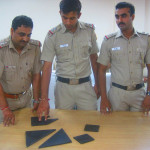Draupadi is an intriguing figure in Indian mythology but whether she should be viewed as a victim or a feminist icon remains a matter of interpretation and subjective ideology. She provides undoutedly the most unique and arguably the only instance of polyandry in Hindu mythological accounts. It is significant that perhaps due to this, unlike others like Sita, Draupadi has never been characterised as Goddess or a figure of reverence. For Gayatri Chakravorti Spivak, Draupadi can be seen as an exceptional figure in the patriarchal context since her marriage to all her five husbands is recognized as legitimate.


Within a patriarchal and patronymic context, she is exceptional, indeed “singular” in the sense of odd, unpaired, uncoupled. Her husbands, since they are husbands rather than lovers, are legitimately pluralized. (Spivak 1981: 387)
It is paradoxical though that she gains this unique status due to being seen, and repeatedly treated throughout the narrative of the epic Mahabharata, as just another object in the anthropological exchange of gifts and possessions between brothers. In the first instance, when Arjun takes her to meet his mother Kunti, the latter without realising asks him to share ‘whatever’ he has brought with all his other brothers. Arjun promptly asks Draupadi to take all five Pandav brothers as her husbands in order to fulfil his mother’s command even though it was given in ignorance of the fact that what her son had brought home was his newly married bride and not just alms received during the day. Similarly, when Yudishtir, the eldest of the Pandava brothers loses all his possessions to his Kaurav cousin Duryodhan during a game of chaupar, it includes his wife since it is reasoned that she is the property of the brothers and would therefore automatically be included in the spoils. Following this, the Kauravs drag Draupadi into the court and attempt to strip her while all the patriarchs of the clan watch silently. In fact, the very reason for the birth of Draupadi, born out of fire due to the prayers of her father the King Drupad, is to enable Drupad to take revenge on Dronacharya. Thus, the entire life of Draupadi as a figure in the Mahabharta, is to fulfil the purpose of exchanges between men in the patriarchal set up. And yet it is also true that inspite of this, Draupadi presents herself as perhaps the strongest female figure in the epic, constantly fighting against injustices. This is what continues to makes her relevant in the contemporary Indian society. I recently saw a play entitled ‘Draupadi’ by the Film and Television Society that draws parallels between the predicaments of patriarchy faced by Draupadi then to the women in India now.
Using a musical narrative style, the play is set up as a conversation between the extended female relatives of a family while the menfolk have gone with the marriage procession for the wedding of the youngest son of the family. The women decide to spend the night enacting scenes from the life of Draupadi which the men of the family forbid them to do otherwise. In between these scenes, where the women take turns enacting the character of Draupadi, they question the reality of their own lives. The married elder daughter of the family recounts how she was not allowed to marry the man she loves because he is from another caste and instead forced into an unhappy marriage. Another young girl in the family remembers her horrific gangrape while coming home in the evening and being blamed for it as she had brought shame and dishonour to the family.
In many ways, the women in this fictitious Haryana village in the play can be seen as standing on the continuum between the classical Draupadi of the epic Mahabharat and the tribal- revolutionary Dopdi of Mahasveta Devi’s bengali short story entitled Draupadi. Like both Draupadi and Dopdi, they inhabit a patriarchal world where they are sexually, physically, politically and economically vulnerable. Like both these characters, they are often forcibly used as pawns to maintain the patriarchal exchanges. Yet unlike the dalit Dopdi who challenges the discourse of honour in Mahasveta Devi’s story, these women from a relatively privileged background never translate their feminist articulations into breaking out of the bondages of the patriarchal facade woven around them. It highlights the feminist concern regarding the shared experiences and yet different political realities of women, and the need to be mindful of difference. The tale of Draupadi can be seen as a tale of honour, family, protest, oppression, revenge and of simulatneously all this, depending on the lens employed to view it. The play much like the literature, and indeed the character of Draupadi herself, opens up the space for renewed discussions of feminism and its continued significance in society today.
Spivak, G. C. (1981). ‘”Draupadi” in Mahasveta Devi’, Critical Inquiry, Vol. 8 (2), pp. 381-402.
About the Author
“Dr Priyasha Kaul is a sociologist. She is an Assistant Professor at FLAME University. Prior to this, she worked at Miranda House, Delhi University and Bristol University (UK). She has taught at Bristol University, London South Bank University, Delhi University and the Indira Gandhi National Open University.”
Discuss this article on Facebook




